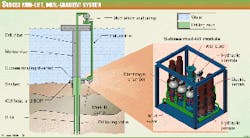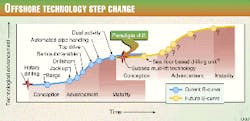Development of a dual-gradient, mud-lift drilling system may push operational limits well beyond 10,000 ft of water, resulting in fewer casing strings and greater safety margins between pore pressure and fracture gradients.
A joint-industry project (JIP) team comprising four operators, four drill- ing contractors, and a manufacturer has spent $14 million since 1996 on conceptual design and critical component development for this technology. The group anticipates spending another $30-35 million before delivering a commercial system in 2002.
"Our goalellipseis to deliver a 121/2-in. well bore to virtually any geologic depth in water depths (of) 10,000 ft and beyond in the Gulf of Mexico," said Conoco Inc.'s Ken Smith, JIP project manager. "From there, we should then be able to drill multilateral wells, install high-rate gravel pack completions, and run 7-in. production tubing."
Today, deepwater drillers use a single-gradient circulation system, where drilling fluids flow down the drillstring, out the bit, up the well annulus, through the riser, and back to the active mud system.
But geological and well-design barriers will eventually prohibit access to ultradeepwater basins with conventional technologies.
For example, as water depths increase in the Gulf of Mexico, so do the number of casing strings needed to overcome problems associated with shallow-water flows, weak formations, lost circulation, underground blow- outs, sloughing shales, and high-pressure zones.
And as deeper prospects force drillers to run more contingency strings, they will eventually reach a point where progressively smaller hole sizes hinder drilling progress or constrain production rates.
The dual-gradient system also circulates drilling fluids down the drill pipe, out the bit, and up the well annulus. At the point where the drilling fluids reach the sea bed, however, a rotating diverter prevents the returning mud from flowing up the riser, redirecting flow instead through a smaller-ID return line (Fig. 1).
To advance fluid flow up the return line, a pump module mounted on the seabed will pump drilling fluids to the active mud system on the surface. This configuration replaces heavy drilling muds in the drilling riser with seawater while retaining the mud column in the well bore.
In addition to readjusting pressure regimes along the well bore, the dual-gradient system may also play an important role in well-control situations.
In conventional drilling situations, "When you have the riser full of mud, you're balancing the well with that riser column," said Bob Kane, director of engineering for Hydril Co. Thus, "At the mud line, it's unbalanced. So when you remove the riser while the well is being drilled, the blowout preventer (BOP) stack is literally holding the remaining well pressure."
With the dual-gradient system, however, "We balance the well bore pressures with the column of mud to the wellhead and the pressure of the seawater. Thus, we can shut the BOP off without the worries of compensating for that missing hydrostatic head," he said.
A system at work
At a recent industry showcase at Hydril's Houston manufacturing site, three primary components of the dual-gradient drilling technology were displayed: the seabed mud-lift pump module, rotating diverter head, and drillstring valve.
The pumping module uses eight hydraulic, variable-displacement pumps driven by four 1,000-hp electric motors to power six 80-gal, positive-displacement diaphragm pumps. The diaphragms separate the mud from the hydraulic power oil, and pilot-operated valves control the flow of oil and drilling mud into and out of the chamber. The chamber is filled with mud, forcing the oil to return to the tank.
The variable-displacement pumps then fill the diaphragm chamber with high-pressure hydraulic oil, forcing mud to flow into the return line to the surface. The hydraulic and mud-control valves are sequenced via the control system to produce this pumping cycle.
To create a smooth fluid flow to the surface, two banks of diaphragm pumps will work in tandem to create a continuous pumping motion.
"It is all electronically controlled, like the timing in your car," Charlie Peterman, director of research for Hydril, told OGJ.
In normal operation, the mud-lift pumps will maintain constant pressure at the wellhead, working in coordination with the surface pumps.
To prevent solids from clogging up the diaphragm, the JIP has developed actuated valves based on those used in other industries to pump solids and contaminated fluids.
"The inlet seal is pressure-energized to seal on the actuated plunger," Peterman said.
Tests have shown that solid particles as large as 2 in. can be passed through the diaphragm pump.
The rotating diverter head serves as the seal between the riser and the well bore.
"We're developing a rotating head that can be delivered and pulled with the drillstring," he said. "We feel that no rotating diverter will reliably last while drilling (the entire hole section), so we'll be able to service it every time we trip the drill pipe."
The final element of the dual-gradient system includes a spring-loaded drillstring valve, a component used to keep the drillstring full of mud.
"When you break a connection out, you have a column from the surface to the bottom of the hole filled with heavy mud. And if you seal this column off in the well bore-for instance, by closing the preventer-you could end up breaking the formation down."
Peterman said the drillstring valve can be operated in a manner that allows shut-in, bottom-hole pressures to be detected based on the standpipe pressure.
A paradigm shift
The dual-gradient, mud-lift technology may take exploration into uncharted territory.
"Just think of the numbers of rigs that have been built for the ultradeepwater, capable of operating in 10,000-12,000 ft," said Bob Rose, president and CEO of Global Marine Inc., Houston. "It's great to have the rig to do it, but we just don't have the technology to go out there in that depth without this type of system being applied."
Jay Miller, associate research scientist with the Ocean Drilling Program, Texas A&M University, named two sedimentary basins that are out of the reach of conventional oil field drilling technologies: the Somali basin in 5,000 m of water and the Arabian basin in 4,000 m. "The deepest water we ever drilled in was 6,000 m," Miller said, "but this was an open-hole situation and excluded the need for BOPs and complex casing strings."
Just as important, the technology may change the ways in which drilling crews conduct offshore operations, much the same way the jack up did in the 1950s (Fig. 2).
"The biggest hurdle is not the equipment," Smith said. "Instead, it is the reeducation and training of the hundreds and hundreds of people who have to go through a big mind-set change before we ever successfully implement mud-lift drilling."
The dual-gradient, mud-lift technology may even lead to the development of entirely new drilling units, such as seabed-based drilling rigs, as proposed by Esso-Lockheed in the 1970s and, more recently, by Herbert Werner, a former German U-boat commander.




